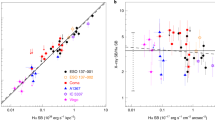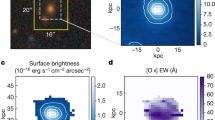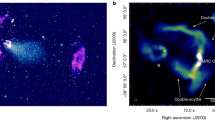Abstract
THE study of radio tail objects is important to our understanding of extragalactic radio sources because the tail morphology allows inference of the temporal evolution of ejected radio components. Furthermore, with increased understanding of these objects, it may be possible to use radio tails as probes of extragalactic space in clusters of galaxies. All published models of radio tails require some form of streamlining resulting from the relative motion of the parent galaxy and the medium producing the tail shape. Therefore, to constrain the relevant dynamical quantities, we have obtained radial velocity measurements for 18 galaxies in the vicinity of A1314, including the two radio tail objects, IC708 and IC711.
This is a preview of subscription content, access via your institution
Access options
Subscribe to this journal
Receive 51 print issues and online access
$199.00 per year
only $3.90 per issue
Buy this article
- Purchase on Springer Link
- Instant access to full article PDF
Prices may be subject to local taxes which are calculated during checkout
Similar content being viewed by others
References
Vallee, J. P., and Wilson, A. S., Nature, 259, 451 (1976).
Pacholczyk, A. G., and Scott, J. S., Astrophys. J., 203, 313 (1976).
Pacholczyk, A. G., Radio Astrophysics (Freeman, San Francisco, 1970).
Tarenghi, M., and Scott, J. S., Astrophys. J. Lett., (in the press).
Author information
Authors and Affiliations
Rights and permissions
About this article
Cite this article
COLEMAN, G., HINTZEN, P., SCOTT, J. et al. The radio tail galaxies in Abell 1314. Nature 262, 476–477 (1976). https://doi.org/10.1038/262476a0
Received:
Accepted:
Issue Date:
DOI: https://doi.org/10.1038/262476a0
This article is cited by
-
The 1 Mpc giant head-tail radio galaxy IC 711: 3-dimensional simulation and additional constraints on the ram pressure theory
Astrophysics and Space Science (1988)
Comments
By submitting a comment you agree to abide by our Terms and Community Guidelines. If you find something abusive or that does not comply with our terms or guidelines please flag it as inappropriate.



